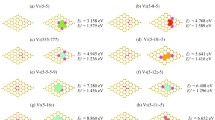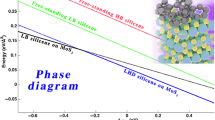Abstract
A comprehensive picture of the initial stages of silicene growth on graphite is drawn. Evidence is shown that quasiparticle interferences play a crucial role in the formation of the observed silicene configurations. We propose, on one hand, that the charge modulations caused by those quantum interferences serve as templates and guide the incoming Si atoms to self-assemble to the unique \(\left( {\sqrt 3 \times \sqrt 3 } \right)\)R30° honeycomb atomic arrangement. On the other hand, their limited extension limits the growth to about 150 Si atoms under our present deposition conditions. The here proposed electrostatic interaction finally explains the unexpected stability of the observed silicene islands over time and with temperature. Despite the robust guiding nature of those quantum interferences during the early growth phase, we demonstrate that the window of experimental conditions for silicene growth is quite narrow, making it an extremely challenging experimental task. Finally, it is shown that the experimentally observed three-dimensional silicon clusters might very well be the simple result of the end of the silicene growth resulting from the limited extent of the quasi-particle interferences.

Similar content being viewed by others
References
Mannix, A. J.; Kiraly, B.; Hersam, M. C.; Guisinger, N. P. Synthesis and chemistry of elemental 2D materials. Nat. Rev. Chem.2017, 1, 0014.
De Crescenzi, M.; Berbezier, I.; Scarselli, M.; Castrucci, P.; Abbarchi, M.; Ronda, A.; Jardali, F.; Park, J.; Vach, H. Formation of silicene nanosheets on graphite. ACS Nano2016, 10, 11163–11171.
Peng, W. B.; Xu, T.; Diener, P.; Biadala, L.; Berthe, M.; Pi, X. D.; Borensztein, Y.; Curcella, A.; Bernard, R.; Prévot, G. et al. Resolving the controversial existence of silicene and germanene nanosheets grown on graphite. ACS Nano2018, 12, 4754–4760.
Ronci, F.; Colonna, S.; Flammini, R.; De Crescenzi, M.; Scarselli, M.; Salvato, M.; Berbezier, I.; Jardali, F.; Lechner, C.; Pochet, P. et al. High graphene permeability for room temperature silicon deposition: The role of defects. Carbon2020, 158, 631–641.
Park, C.; Yang, H.; Mayne, A. J.; Dujardin, G.; Seo, S.; Kuk, Y.; Ihm, J.; Kim, G. Formation of unconventional standing waves at graphene edges by valley mixing and pseudospin rotation. Proc. Natl. Acad. Sci. USA2011, 108, 18622–18625.
Castrucci, P.; Fabbri, F.; Delise, T.; Scarselli, M.; Salvato, M.; Pascale, S.; Francini, F.; Berbezier, I.; Lechner, C.; Jardali, F. et al. Raman investigation of air-stable silicene nanosheets on an inert graphite surface. Nano Res.2018, 11, 5879–5889.
Yue, N. L.; Myers, J.; Su, L. Q.; Wang, W. T.; Liu, F. D.; Tsu, R.; Zhuang, Y.; Zhang, Y. Growth of oxidation-resistive silicene-like thin flakes and Si nanostructures on graphene. J. Semicond.2019, 40, 062001.
Kresse, G.; Furthmüller, J. Efficiency of ab-initio total energy calculations for metals and semiconductors using a plane-wave basis set. Comput. Mater. Sci.1996, 6, 15–50.
Kresse, G.; Furthmüller, J. Efficient iterative schemes for ab initio total-energy calculations using a plane-wave basis set. Phys. Rev. B1996, 54, 11169–11186.
Perdew, J. P.; Burke, K.; Ernzerhof, M. Generalized gradient approximation made simple. Phys. Rev. Lett.1996, 77, 3865–3868.
Grimme, S. Semiempirical GGA-type density functional constructed with a long-range dispersion correction. J. Comput. Chem.2006, 27, 1787–1799.
Blöchl, P. E. Projector augmented-wave method. Phys. Rev. B1994, 50, 17953–17979.
Windiks, R.; Delley, B. Massive thermostatting in isothermal density functional molecular dynamics simulations. J. Chem. Phys.2003, 119, 2481–2487.
Nosé, S. A unified formulation of the constant temperature molecular dynamics methods. J. Chem. Phys.1984, 81, 511–519.
Cai, Y. M.; Chuu, C. P.; Wei, C. M.; Chou, M. Y. Stability and electronic properties of two-dimensional silicene and germanene on graphene. Phys. Rev. B2013, 88, 245408.
Prévot, G.; Bernard, R.; Cruguel, H.; Curcella, A.; Lazzeri, M.; Leoni, T.; Masson, L.; Ranguis, A.; Borensztein, Y. Formation of silicene on silver: Strong interaction between Ag and Si. Phys. Status Solidi B2016, 253, 206–217.
Díaz Álvarez, A.; Zhu, T.; Nys, J. P.; Berthe, M.; Empis, M.; Schreiber, J.; Grandidier, B.; Xu, T. Scanning tunneling spectroscopy and Raman spectroscopy of monolayer silicene on Ag(111). Surf. Sci.2016, 653, 92–96.
Crommie, M. F.; Lutz, C. P.; Eigler D. M. Imaging standing waves in a two-dimensional electron gas. Nature1993, 363, 524–527.
Hasegawa, Y.; Avouris. Direct observation of standing wave formation at surface steps using scanning tunneling spectroscopy. Phys. Rev. Lett.1993, 71, 1071–1074.
Petersen, L.; Sprunger, P. T.; Hofmann; Lægsgaard, E.; Briner, B. G.; Doering, M.; Rust, H. P.; Bradshaw, A. M.; Besenbacher, F.; Plummer, E. W. Direct imaging of the two-dimensional Fermi contour: Fouriertransform STM. Phys. Rev. B1998, 57, R6858–R6861.
Reifenberger, R. Lessons from Nanoscience: A lecture notes series: Volume 4, fundamentals of atomic force microscopy, Part I: Foundations, 2015; pp 49. https://doi.org/10.1142/9343.
Yang, H.; Mayne, A. J.; Boucherit, M.; Comtet, G.; Dujardin, G.; Kuk, Y. Quantum interference channeling at graphene edges. Nano Lett.2010, 10, 943–947.
Rutter, G. M.; Crain, J. N.; Guisinger, N. P.; Li, T.; First, P. N.; Stroscio, J. A. Scattering and interference in epitaxial graphene. Science2007, 317, 219–222.
Iannuzzi, M.; Kalichava, I.; Ma, H. F.; Leake, S. J.; Zhou, H. T.; Li, G.; Zhang, Y.; Bunk, O.; Gao, H. J.; Hutter, J. et al. Moiré beatings in graphene on Ru(0001). Phys. Rev. B2013, 88, 125433.
Gupta, V.; Kumar, A.; Ray, N. Permeability of two-dimensional graphene and hexagonal-boron nitride to hydrogen atom. AIP Conf. Proc.2018, 1953, 140013.
Tchalala, M. R.; Enriquez, H.; Bendounan, A.; Mayne, A. J.; Dujardin, G.; Kara, A.; Ali, M. A.; Oughaddou, H. Tip-induced oxidation of silicene nano-ribbons. Nanoscale Adv.2020, doi=https://doi.org/10.1039/D0NA00332H.
Acknowledgements
We are most thankful to Dr. Andrew Mayne who shared his in-depth understanding of quantum interferences with us in several exciting and encouraging discussions. H. V., F. J., and C. L. gratefully acknowledge the HPC centers of IDRIS (Grant A004-090642) and CERMM for computational resources. F. J. acknowledges the Hariri Foundation for Sustainable Human Development for the scholarship that was awarded to her during her PhD studies. We would like to express our most sincere thanks to Prof. Chih-Piao Chuu for having kindly provided us with the structure files of his most stable silicene configurations. M. D. C., M. S. and P. C. acknowledge the European Community for the HORIZON 2020 MSC-RISE Project DiSeTCom (GA 823728). Many thanks are also due to Dr. James Creel for the careful reading of the present manuscript. We finally would like to acknowledge the fruitful discussions we had with Prof. Sanjay Mathur at the University of Köln.
Author information
Authors and Affiliations
Contributions
The manuscript results from an intensive collaboration between experimentalists and theoreticians; the theory has been proposed and all simulations have been performed by F. J., C. L., and H. V. All authors have given approval to the final version of the manuscript.
Corresponding author
Rights and permissions
About this article
Cite this article
Jardali, F., Lechner, C., De Crescenzi, M. et al. The potentially crucial role of quasi-particle interferences for the growth of silicene on graphite. Nano Res. 13, 2378–2383 (2020). https://doi.org/10.1007/s12274-020-2858-x
Received:
Revised:
Accepted:
Published:
Issue Date:
DOI: https://doi.org/10.1007/s12274-020-2858-x




